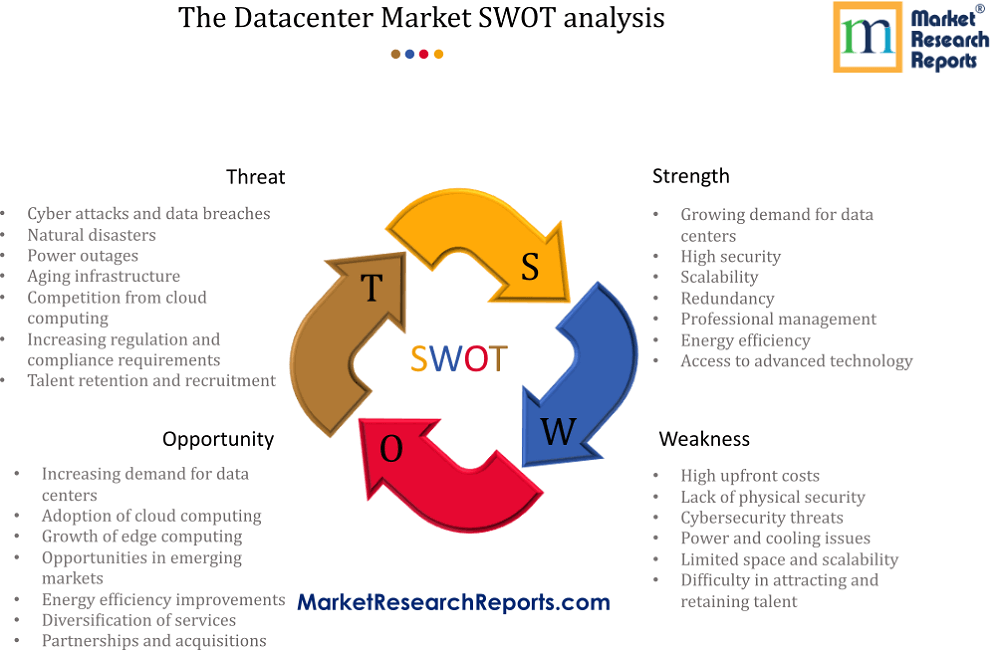The Datacenter Market SWOT analysis highlights the challenges and opportunities present in the industry

Data centers are facilities that house computer systems and associated components, such as telecommunications and storage systems. They are used to store, process, and manage large amounts of data and are essential to many businesses, organizations, and institutions. Because data centers consume a significant amount of energy, it is critical to design and operate them in an energy-efficient manner.
Suggested Market Reports for Investors
- Global Data Center Immersion Cooling Services Market
- Hyperscale Data Center Market
- Global Data Center Colocation Market
1 . SWOT Analysis of Datacenter Market
Here in this blog post, I have tried to sum up a few points that can be turned into a detailed SWOT analysis of the data center industry; Since, by the nature of SWOT analysis, strengths overlap opportunities and weaknesses overlap threats; You may find redundancies and similarities in some points.

2 . Strengths
Growing demand for data centers
As more and more people and businesses rely on the internet for communication, data storage, and other services, the need for data centers has increased. This trend is backed by recent data such as the Data Centres providers in the Asia Pacific region are amongst the fastest growing in the world, with South Korea forecast to a growth of 100%. With the rise of the internet of things (IoT) and the proliferation of devices that generate and collect data, the need for data storage has grown significantly. Data centers provide the necessary infrastructure to store and manage this data.
- Increasing reliance on technology: With the increasing use of technology in businesses and personal lives, there is a growing demand for data storage and processing. Data centers provide the infrastructure to store, process, and transmit data efficiently.
- Growth of cloud computing: Cloud computing has become increasingly popular in recent years, with businesses and individuals using it to store and access data from anywhere. Data centers are crucial in providing cloud services, as they provide the infrastructure necessary to store and process data in the cloud.
- Big data analytics: The amount of data generated by businesses and individuals is increasing rapidly, and data centers are necessary to store and process this data for analysis. This allows businesses to make better decisions based on data-driven insights.
- Disaster recovery: Data centers also serve as a backup for businesses in the event of a disaster, allowing them to access their data and continue operations even if their primary location is affected.
- Government regulations: In some industries, there are government regulations that require businesses to store and process data in secure data centers to ensure data privacy and security.
High security
Data centers prioritize the security of their systems and the data they store, with multiple layers of protection such as firewalls, intrusion detection systems, and physical security measures.
- Physical security measures: A data center should have strong physical security measures in place, such as access control systems, security cameras, and perimeter fencing to protect against unauthorized access.
- Network security: Data centers should have robust network security measures, such as firewalls, intrusion detection systems, and encryption technologies to protect against cyber attacks and data breaches.
- Disaster recovery and backup systems: Data centers should have robust disaster recovery and backup systems in place to ensure that data is protected in the event of a disaster or system failure.
- Security training and awareness: Data center employees should receive ongoing security training and awareness to ensure they are aware of potential threats and how to prevent them.
- Compliance with industry standards: Data centers should comply with industry standards, such as PCI DSS and HIPAA, to ensure they meet the necessary security requirements for handling sensitive data.
Scalability
Data centers can scale up or down as needed, allowing businesses to adapt to changes in their data storage and processing needs once such an opportunity provides by hyperscale data centers. Hyperscale data centers are large-scale, highly efficient facilities designed to support significant, high-demand organizations' storage and processing needs, such as cloud service providers, internet companies, and enterprise data centers. Hyperscale Data Centres under construction worldwide come to a total of 921,458 m2 of Data center space and just under 2,000 MW of power.
- Cost efficiency: Hyperscale data centers are designed for maximum efficiency, allowing them to operate at a lower cost than traditional data centers. They use advanced technologies such as virtualization, automation, and cloud computing to optimize operations and reduce energy consumption.
- Scalability: Hyperscale data centers are highly scalable, allowing them to quickly and easily add more servers and storage as needed. This is particularly important for businesses that experience rapid growth or sudden spikes in demand.
- Reliability: Hyperscale data centers use redundant and advanced monitoring systems to ensure uptime and reliability. This is especially important for mission-critical applications that must be available at all times.
- Security: Hyperscale data centers use advanced security measures to protect data and prevent unauthorized access. This includes physical security measures such as fences, guards, and biometric scanners and digital security measures such as encryption and firewalls.
- Sustainability: Hyperscale data centers use various technologies to reduce their environmental impact. This includes using renewable energy sources, implementing energy-efficient systems, and recycling waste materials.
Redundancy
Data centers often have redundant systems in place to ensure that data is not lost in the event of a system failure. This includes redundant power supplies, servers, and storage systems.
There are several advantages of redundancy in data centers:
- Improved reliability and security: Redundancy helps to ensure that the data center remains operational even if one of the systems fails. This increases the overall reliability of the data center. Enhanced security: Redundancy can also help to improve security by providing multiple layers of protection. For example, if one system is compromised, the redundant system can take over to keep the data center secure.
- Increased uptime and reduced downtime: Redundancy helps to increase the uptime of a data center, which is critical for businesses that rely on the data center for their operations. If one system fails, the redundant system can take over immediately, which helps to reduce downtime and minimize the impact on business operations.
- Cost-effectiveness: Although redundancy can be costly to implement, it can save businesses money in the long run by reducing the risk of costly downtime and data loss.
Professional management
Data centers are typically operated by skilled professionals who are trained in data management and security, ensuring that systems are maintained and operated efficiently.
- Improved security and enhanced performance: Professional managed data centers have advanced security measures in place to protect against cyber attacks and data breaches. This includes firewalls, intrusion detection systems, and 24/7 monitoring to ensure that all data is kept safe and secure.
- Managed data centers are designed to optimize performance, with fast and reliable servers, advanced networking infrastructure, and high-quality power and cooling systems. This ensures that businesses can rely on their systems to perform at their best, even during peak times of usage.
- Expert support: Managed data centers come with a team of experienced technicians who can provide expert support and assistance whenever it is needed. This can help businesses avoid costly downtime and ensure that their systems are always running smoothly.
- Cost savings: Outsourcing data center management to professionals can save businesses money in the long run. They can avoid the upfront costs of building and maintaining their own data center, as well as the ongoing expenses of hiring in-house IT staff.
Energy efficiency
Many data centers have implemented measures to reduce their energy consumption, such as using renewable energy sources or implementing energy-efficient systems.
There are several ways to achieve energy efficiency in data centers:
- Implementing virtualization: Virtualization allows multiple servers to run on one physical machine, reducing the number of servers required and therefore energy consumption. Using energy-efficient hardware: Data centers can use servers, storage devices, and other hardware that are designed to be energy efficient and use less power.
- Using power management techniques: Data centers can use techniques such as power capping, power cycling, and power distribution to manage their hardware's power consumption better.
- Utilizing free cooling: Data centers can use free cooling techniques such as using outside air to cool the facility instead of relying on mechanical cooling systems.
- Implementing server consolidation: Data centers can consolidate servers and workloads to reduce energy consumption and improve energy efficiency.
- Using energy-efficient lighting: Data centers can use LED lighting or other energy-efficient lighting systems to reduce energy consumption.
- Implementing renewable energy sources: Data centers can use renewable energy sources such as solar panels or wind turbines to power their facilities and reduce their carbon footprint.
Access to advanced technology
Data centers often have access to the latest and most advanced technologies, allowing businesses to take advantage of cutting-edge solutions for their data storage and processing needs.
- Virtualization: Data centers use virtualization technologies such as VMware or Hyper-V to create virtual machines (VMs) that can run multiple operating systems and applications on a single physical server. This allows data centers to reduce their hardware requirements and increase efficiency.
- Cloud computing: Data centers often use platforms such as Amazon Web Services (AWS), Microsoft Azure, or Google Cloud Platform to host applications and data in a remote, virtual environment. This allows data centers to scale their resources up or down as needed and pay only for the resources they use.
- Containers: Data centers may also use container technologies such as Docker to deploy and manage applications in a lightweight, portable manner. Containers allow data centers to quickly and easily deploy and scale applications across multiple servers, making them ideal for microservices architectures.
- Artificial intelligence (AI) and machine learning: Data centers may use AI and machine learning technologies to automate tasks, improve efficiency, and analyze large amounts of data. For example, a data center may use machine learning algorithms to optimize server usage or predict hardware failures.
- Automation and orchestration: Data centers may use automation and orchestration tools to manage and deploy their IT infrastructure and applications. This can include tools such as Ansible, Puppet, or Terraform, which allow data centers to automate repetitive tasks and deploy resources quickly and consistently.
3 . Weaknesses:
High upfront costs
Setting up and maintaining a data center can be expensive, particularly for small businesses. For example, new Hyperscale Data Centre facilities require an investment of USD 200 million per facility. Some of the investments can be considerably higher for campus Data Center sites at around USD 1 billion.
Lack of physical security
Data centers are vulnerable to physical attacks such as vandalism, theft, and natural disasters. Operators need to implement robust security measures to protect the facility and its data.
Cybersecurity threats
Data centers are also vulnerable to cyber attacks such as hacking, malware, and ransomware. Operators must ensure that their systems and networks are secure and regularly update their security protocols to protect against new threats.
Power and cooling issues
Ensuring a reliable power supply and maintaining proper temperature and humidity levels within the data center are crucial for the proper functioning the equipment. Operators must invest in robust power and cooling systems to prevent outages and equipment failure.
Limited space and scalability
As data centers continue to grow, operators may face challenges in finding suitable locations with enough space to accommodate their clients' increasing demands. Operators also need to ensure that their data centers can scale quickly and efficiently to meet the changing needs of their clients.
Difficulty in attracting and retaining talent
Data center operators often struggle to attract and retain skilled and experienced professionals to manage and maintain their facilities' complex systems and equipment. This can lead to a lack of expertise and efficiency within the organization.
4 . Opportunities:
Increasing demand for data centers
With the increasing reliance on technology and the internet, there is a growing demand for data centers to store and process data. This presents an opportunity for data center operators to meet this demand by building and operating new data centers.
By 2030, the global Data Centre market will see several changes, and believes content hubs with connectivity to subsea cable systems are becoming a feature of new Data Centre markets. Data Centre raised floor space will grow by 73 percent worldwide over the four years to the end of 2026, by region the forecast growth rates are:
- EMEA region - by 124%
- Asia region - by 60%
- Americas region - by 47%
Adoption of cloud computing
The shift towards cloud computing creates opportunities for data center operators to offer hosting and storage services to businesses. This includes providing infrastructure as a service (IaaS), platform as a service (PaaS), and software as a service (SaaS) solutions.
Growth of edge computing
The rise of edge computing, which involves processing data closer to the source rather than in a centralized location, presents opportunities for data center operators to build and operate edge data centers.
Opportunities in emerging markets
Data center operators can expand their operations into emerging markets, where there may be a growing demand for data center services.
Energy efficiency improvements
Data centers are known for their high energy consumption, so there are opportunities for data center operators to implement energy-efficient technologies and practices to reduce their carbon footprint and save on energy costs.
The increase in power per new Data Centre facility also ensures that power availability becomes a key pre-requisite in selecting a potential Data Centre location. In some highly populated cities, there is a shortage of available space and power for new Data Centre facilities, with Data Centre Providers now being restricted to building in. For example, Data Centres with over 0.5 MW of power in Norway will have to consider connecting to a municipal heat recovery network to distribute heat from the facility.
Diversification of services
Data center operators can diversify their services by offering additional services such as managed IT services, cybersecurity, and disaster recovery solutions.
Partnerships and acquisitions
Data center operators can expand their operations through partnerships and acquisitions of other data center companies or related businesses.
5 . Threats:
Cyber attacks and data breaches
As data centers store and process sensitive data, they are often targeted by cybercriminals looking to steal sensitive information or disrupt operations.
Natural disasters
Data centers are vulnerable to damage from natural disasters such as earthquakes, floods, and hurricanes, which can lead to costly downtime and data loss.
Power outages
Data centers rely on a stable and reliable power supply to function, and any disruptions in power can lead to costly downtime.
Aging infrastructure
As data centers age, their infrastructure becomes increasingly outdated and susceptible to failure.
Competition from cloud computing
The rise of cloud computing has led to increased competition for data center providers as businesses increasingly turn to cloud-based solutions for their data storage and processing needs.
Increasing regulation and compliance requirements
Data centers must adhere to strict regulatory and compliance requirements, which can be costly and time-consuming.
Talent retention and recruitment
Finding and retaining skilled personnel to work in data centers can be challenging, as the industry faces a shortage of qualified professionals.





